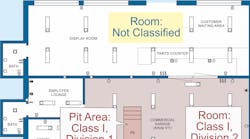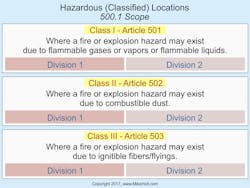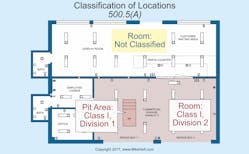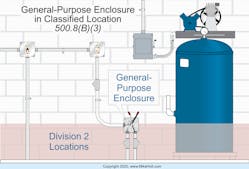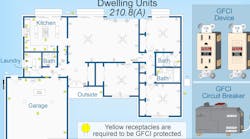A hazardous (classified) location is an area where the possibility of fire or explosion exists because of flammable or combustible gases or vapors, combustible dusts, or easily ignitable fibers/flyings. Article 500 contains a general background on hazardous (classified) locations, and it describes the differences between Class I, II, and III locations as well as the difference between Division 1 and Division 2 in each of the three classifications (Fig. 1). This gives you a foundation for applying the rules for hazardous locations in subsequent articles. These are Art. 501 (Class I Locations), Art. 502 (Class II Locations), Art. 503 (Class III Locations), Art. 504 (Intrinsically Safe Systems), and Arts. 510 through 516 (specific types of occupancies). Articles 501, 502, and 503 contain the actual Class I, Class II, and Class III installation requirements, including wiring methods, seals, and specific equipment requirements.
Classifications
Locations are classified based on the properties of the flammable gases, flammable liquid‑produced vapors, combustible liquid‑produced vapors, combustible dusts, or easily ignitable fibers/flyings that may be present, and the likelihood that a flammable or combustible concentration will be present [Sec. 500.5(A)].
Each room, section, or area is considered individually in determining its classification (Fig. 2). The same structure might contain any combination of Class I, Division 1 and 2 locations; Class II, Division 1 and 2 locations; and/or Class III, Division 1 and 2 locations.
• Class I locations are where flammable gases, flammable liquid‑produced vapors, or combustible liquid‑produced vapors may be present in quantities sufficient to produce explosive or ignitable mixtures [Sec. 500.4(B)].
• Class II locations are those where the presence of combustible dust may be suspended in the air or accumulate on electrical equipment in quantities sufficient to ignite or explode [Sec. 500.4(C)].
• Class III locations are those where easily ignitable fibers or materials producing combustible flyings are handled, manufactured, or used and aren’t likely to be suspended in the air in quantities sufficient to produce ignitable mixtures [Sec. 500.4(D)].
Class I and II locations are broken down further into Division 1 and Division 2. In a nutshell:
• Division 1 applies to normal conditions. For example (in Class I), ignitable vapors are usually present or may be present frequently due to routine maintenance. The same logic applies to Class II, except the ignitables are different.
• Division 2 applies to abnormal conditions. For example (in Class I), ignitable vapors are not usually present but abnormal operation can result in their release. The same logic applies to Class II, except the ignitables are different.
For Class III, Division 1 applies to any of several conditions and Division 2 applies to everything but manufacturing of the combustible.
Protection techniques
Acceptable protection techniques in hazardous (classified) locations include [Sec. 500.7]:
(A) Explosionproof equipment. It’s permitted in any Class I location for which it’s identified. Explosionproof equipment is designed to be capable of withstanding and containing the force of an internal explosion, and the hot gases within the enclosure cool as they escape [Art. 100 — Definitions].
(B) Dust‑Ignitionproof enclosures. They are permitted in any Class II location. Dust‑ignitionproof enclosures are designed to exclude dusts and won’t permit arcs, sparks, or heat within the enclosure to cause the ignition of exterior dust [Art. 100 — Definitions].
(C) Dust-tight enclosures. They are permitted in Class II, Division 2 or any Class III location.
(D) Purged and pressurized systems. They are permitted for equipment in any hazardous (classified) locations for which they’re identified.
(E) Intrinsically safe systems. They are allowed in any hazardous (classified) location. None of the requirements contained in Arts. 501 through 503, or Arts. 510 through 516 apply to intrinsically safe system installations, except as required by Art. 504. Intrinsically safe systems are incapable of releasing sufficient electrical or thermal energy to cause ignition of flammable gases or vapors [Sec. 504.2].
(F), (G), and (H). Nonincendive circuit, equipment, or component, respectively. This protection isn’t permitted in Class I or II, Division 1 locations.
(I) Oil‑immersed make‑and‑break contacts. These can be installed in a
Class I, Division 2 location.
(J) Hermetically sealed contacts. These contacts can be installed in Class I, Division 2; Class II, Division 2; or Class III, Division 1 and 2 Locations.
(L) Other protection techniques. These apply to equipment identified for use in hazardous (classified) locations. But the NEC is silent on the meaning of this Section.
Equipment
Suitability of identified equipment must be determined by any of the following [Sec. 500.8(A)]:
(1) Equipment listing or labeling.
(2) Evidence of evaluation by a qualified testing laboratory or inspection agency concerned with product evaluation.
(3) Evidence approved by the authority having jurisdiction (AHJ), such as a manufacturer’s self‑evaluation or an owner’s engineering judgment.
Informational Note: Additional documentation may include certificates demonstrating compliance with applicable equipment standards, indicating special conditions of use, and other pertinent information.
Equipment installed in any hazardous (classified) location must be identified for the class and explosive, combustible, or ignitable properties of the specific gas, vapor, dust, or fiber/flyings that will be present. Equipment in Class I locations must not have any exposed surfaces that reach temperatures higher than the autoignition temperature of the gas or vapor present [Sec. 500.8(B)(1)].
Equipment identified for Class I, Division 1 locations can be installed in a Class I, Division 2 location of the same class, group, and temperature class [Sec. 500.8(B)(2)].
General‑purpose enclosures not containing make‑and‑break contacts can be installed in a Division 2 location [Sec. 500.8(B)(3)] (Fig. 3).
Class I equipment must not permit the exposed equipment surface to operate at a temperature in excess of the autoignition temperature of the specific gas or vapor, as listed in Table 500.8(C) [Sec. 500.8(D)(1)].
This is accomplished by ensuring that the temperature marking on the equipment (especially luminaires and motors) doesn’t exceed the autoignition temperature of the specific gas or vapor to be encountered.
Class II equipment must not allow the exposed equipment surface to operate at a temperature in excess of the autoignition temperature of the specific dust, as listed in Table 500.8(C) [500.8(D)(2)].
This is accomplished by ensuring that the temperature marking on the equipment (especially luminaires) doesn’t exceed the autoignition temperature of the specific dust to be encountered.
Threaded conduits must be made wrenchtight to prevent arcing when ground‑fault current flows through the raceway system and to ensure the explosionproof or dust‑ignitionproof integrity of the raceway system [Sec. 500.8(E)].
Threaded entries into explosionproof equipment must be made up with at least five threads fully engaged. Exception: For listed explosionproof equipment, factory‑threaded entries must be made up with at least 4½ threads fully engaged.
This thread requirement ensures that if an explosion occurs within a raceway or enclosure, the expanding gas will sufficiently cool as it dissipates through the threads. This prevents hot flaming gases from igniting the surrounding atmosphere of a hazardous (classified) location.
Keep in mind that it’s assumed the flammable atmosphere outside the raceway will seep into the raceway system over time. The goal of the Code is to contain any explosion that occurs inside the raceway so the event won’t ignite the flammable mixture outside the raceway.
Unused openings must be closed with listed metal close‑up plugs in accordance with Sec. 500.8(E) [110.12(A)].
Optical fiber cable must be installed to address the associated fire hazard and sealed to address the associated explosion hazard in accordance with Arts. 500, 501, 502, or 503 [Sec. 500.8(F)].
Avoiding mistakes
Always know the Class and Division of the specific area where your equipment is located. Sometimes, equipment is located on a classification boundary; when that’s the case, go with the higher classification, or move the equipment off the boundary. Sometimes, equipment is located adjacent to an area with a more stringent classification; the NEC addresses this situation for each Class and Division.
The NEC does not prevent you from exceeding the requirements for a given Class and Division. Theoretically, you could install everything as Class I, Division 1 providing it’s listing for the other locations. But that’s inordinately expensive, and it won’t bring any benefit beyond what you get by meeting the applicable requirements. This fact is why we have the granularity provided by the Class and Division system.
Just as it’s a mistake to under-protect an area (incurring excessive risk), it’s also a mistake to over-protect it (incurring excessive cost). But situations may arise where it’s unclear what to do. In those situations, risk mitigation must always trump cost mitigation. After all, reducing the risk of fire or explosion is why hazardous location rules exist.
Holt is the owner of Mike Holt Enterprises, Inc. in Leesburg, Fla. He can be reached at www.mikeholt.com.